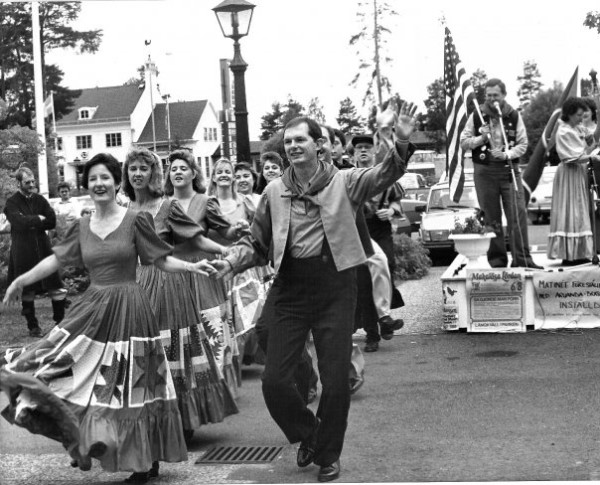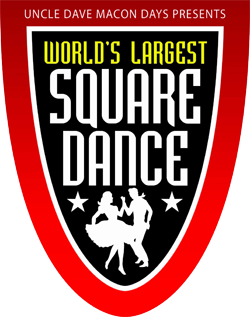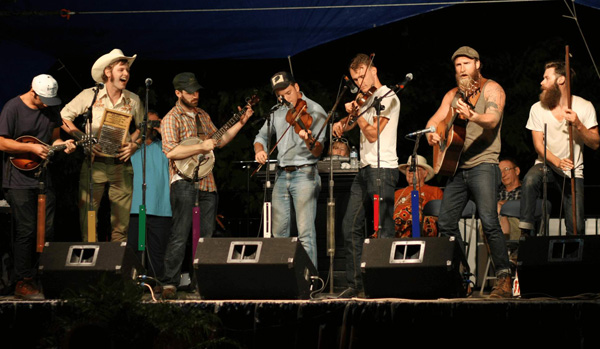
photo courtesy of cripplecreekcloggers.org
Today in America, we find ourselves largely devoid of the pleasures provided by that great period in our history when American folk dances thrived and were as prevalent as the “Golden Rule” in communities across the land. A square is a dance for four couples (eight dancers) arranged in a square, with one couple on each side, facing the middle of the square. A type of square dance was first documented in 17th-century England, but was also quite common in France and throughout Europe. It came to North America with the European settlers, and has since undergone considerable development and transition. In some countries and regions, through preservation and repetition, square dances have attained the status of a folk dance. The Western American square dance may be the most widely known form worldwide, possibly due to its association in the 20th century with the romanticized image of the American cowboy. Square dancing is, therefore, strongly associated with the United States. Nineteen U.S. states, including Tennessee, have designated the “square dance” as their official state dance.
Up into the mid-20th century, square dancing was a part of an ever-changing, emerging American culture. Americans have always been music lovers and have loved to dance. Even the attitude of the pilgrims was that “all good people should dance from the angels on down!” From the early Colonial days prior to the American Revolution, settlers lived in remote areas with the nearest neighbors literally miles away. In the midst of the hardships and difficulties in settlers’ lives, the square dance created a sense of community in a playful, non-threatening atmosphere. Most dances were so simple that they could be learned by participants as they danced. Some erupted into a “jig,” clog or buck dance, showing tests of endurance.
It was the War of 1812 with England that ensured the popularity and development of the square dance in America. Most Americans at the time refused to dance English dances, but the French squares were acceptable. At that time, the “caller” was incorporated into the square dance. A fiddler would serve as the leader, telling the dancers what to do next as well as playing the tune for the dancers to follow. Fiddle-tune books became popular for all to learn and play for the square dances. Calls were sung and spoken during the dance. By the 1870s, singing calls were common across America, according to S. Foster Damon’s The History of Square-Dancing.
In 1877 Americans debated whether or not to ban all square dancing. Some square dancers would clasp their partners too closely in their arms and revolve in circles around the dance area waltzing dizzily. This was considered by many to be the depths of vulgarity and wickedness.
By the 1890s, most square dancing was ebbing from sight in urban areas. It continued to thrive in the South and the West with styles that are familiar today. Americans would continue to learn about their rich square-dance heritage in schools and colleges. It was thought that the square dance would become melded into the culture. But in February of 1916, The American Folk Dance Society was formed. The old fiddle-tune books were still in print and had survived into the early 20th century.
Then in 1925, Henry Ford, the man who had done more to change the face of America than any other, wanted to save the American square dance. The founder of the Ford Motor Company and his wife, Clara Bryant, loved to dance. Mr. Ford began his search for someone to teach square dancing. In 1923, he purchased the Wayside Inn because of its beautiful ballroom. Shortly after purchasing the Wayside Inn, Mr. Ford found Benjamin Lovett (1876–1952) and his wife, Charlotte L. Cooke. Henry Ford felt Benjamin Lovett to be the perfect teacher of “old fashion” dances, and in 1924 Benjamin Lovett began teaching classes for Mr. Ford, an arrangement that lasted more than 20 years. Square dancing, along with quadrilles, two-steps, waltzes and other old-fashioned dances, became a part of life for Ford employees and school children across the United States.
In his book Good Natured Riot, Charles Wolfe discusses the influence of Henry Ford on old-time fiddle music. Ford and Lovett believed square dancing taught social training, courtesy and good citizenship, along with rhythm. They felt it should be a part of every school’s teaching of physical education. Many American children (including myself) of the 1950s and ’60s can credit (or blame) Mr. Ford for that after-lunch square-dance instruction in their gym classes.
Around 1928, boards of education all over the United States endorsed their square dancing program. Almost half the public schools in America began teaching square dancing and other old-fashioned dancing. Not only was this great exercise, but Ford and Lovett felt square dancing corrected the missing fun and teamwork that one-on-one dance lacked. Ford and Lovett felt that having square dancing in schools would help train children in manners, courtesy and social training, qualities Henry Ford wanted to see developed in people.
Many have felt that square dancing was great for balancing exercises, rhythm, manners, poise and grace, along with giving self-confidence, overcoming timidity and fostering appreciation of good music. Throughout American history, square dancing has been a great way to build community and to simply have fun.
Throughout the early years, the square dance, along with the old-time fiddle band, was a paragon of continuity, weathering various fads and innovations of country music. The indescribable string-band sounds coupled with the uncompromising zeal and drive of the square dance is still the standard for the Grand Ole Opry.
 Somehow once again, we yearn for some of that authenticity—the relatively uncontaminated and unspoiled old-time music of those days. These tunes bring us back to an uninhibited, joyful expression that is contagious, unraveling our fear and anxiety. In a sense in our day, we are craving this kind of music and dance expression. Not only is it filled with fun and frolic, but it is healthy and healing to the soul. The endearing quality of the content from those old tunes has an effect that is indescribable and infectious.
Somehow once again, we yearn for some of that authenticity—the relatively uncontaminated and unspoiled old-time music of those days. These tunes bring us back to an uninhibited, joyful expression that is contagious, unraveling our fear and anxiety. In a sense in our day, we are craving this kind of music and dance expression. Not only is it filled with fun and frolic, but it is healthy and healing to the soul. The endearing quality of the content from those old tunes has an effect that is indescribable and infectious.
New for 2016 Uncle Dave Macon Days, coming up July 7–9, is an attempt to break the Guinness record for the World’s Largest Square Dance. The high-energy, rollicking sounds of the Hog Slop String Band will lead the attempt for the World’s Largest Square Dance.
On the evening of July 7, at 6 p.m., Marcia Campbell from Grand Ole Opry Dancers and WSM 650 will help kick off Uncle Dave Macon Days with the attempt to take the World’s Largest Square Dance record from Illinois. This free event will draw thousands of dancers back to the Square where Uncle Dave Macon Days began nearly 40 years ago.
There will be a communitywide square dance rehearsal on Sunday, May 15, at 2 p.m. at the Rutherford County Courthouse Inner Circle. All those interested in participating as a either a dancer or volunteer, please come.
For more information, call (615) 893-2371 or visit uncledavemacondays.com/the-worlds-largest-squaredance.














